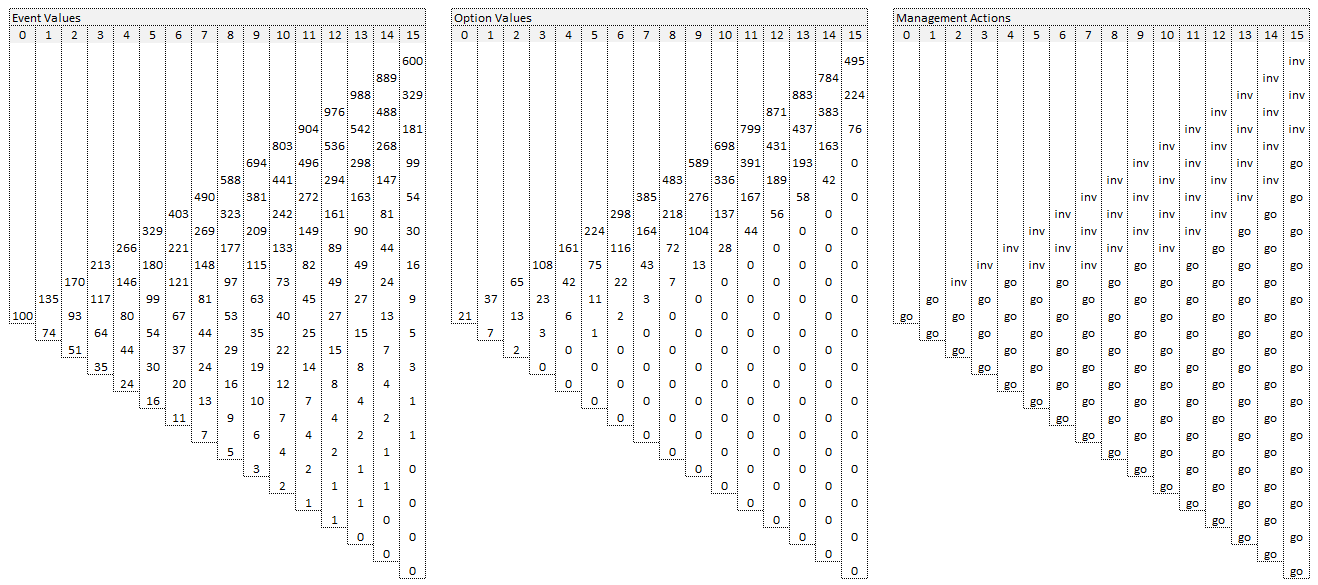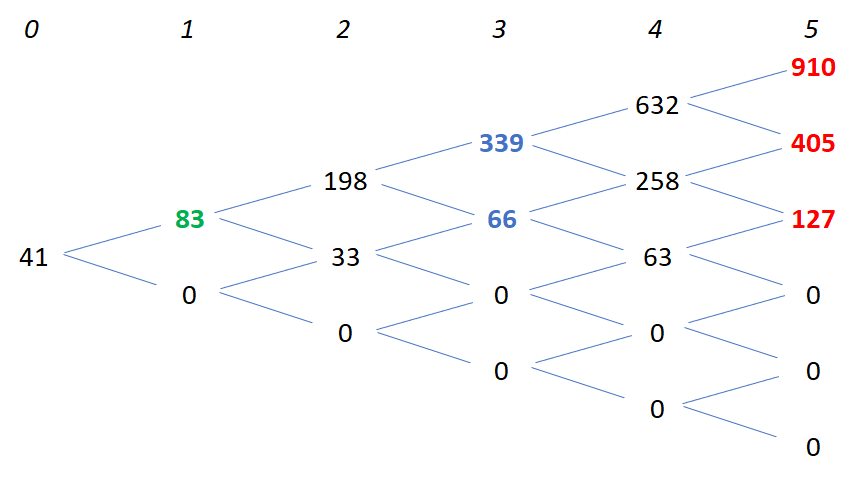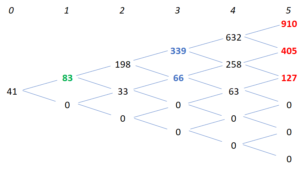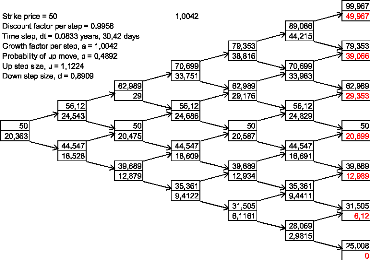Joachim Kuczynski, 24 October 2023
Introduction
In this article I want to derive the explicit relationship between an option value and the probability of occurrence of its event states in the binomial model of Cox, Ross and Rubinstein. In many cases I read that the risk neutral probabilities and therefore the option value do not depend on the probabilities of the real state values. But the options values depend on them implicitly. That is what I will derive in this post.
Binomial Model by Cox, Ross and Rubinstein
Options can be valued with the binomial model from Ross, Cox and Rubinstein. The value ![]() of an option at time
of an option at time ![]() is given by:
is given by:
![]()
![]() and
and ![]() are the option values of the up and down development at time
are the option values of the up and down development at time ![]() .
. ![]() is the risk free rate and T is the time between
is the risk free rate and T is the time between ![]() and
and ![]() ,
, ![]() .
. ![]() is the risk neutral probability of the up movement in
is the risk neutral probability of the up movement in ![]() ,
, ![]() is the risk neutral probability of the down movement in
is the risk neutral probability of the down movement in ![]() . The binomial model provides the following relationship:
. The binomial model provides the following relationship:
![]()
Including ![]() provides this expression for
provides this expression for ![]()
![Rendered by QuickLaTeX.com \[C_0=\frac{\frac{(1+r)^T-d}{u-d} C_{u,t_1}+(1-\frac{(1+r)^T-d}{u-d} )C_{d,t_1}}{(1+r)^T }\]](https://www.financeinvest.at/wp-content/ql-cache/quicklatex.com-4585ecf3307b3ea36a992a134bd156a8_l3.png)
Hence we obtain:
![]()
![]() and
and ![]() are defined as ratio of up and down movement in relation to the expected value in
are defined as ratio of up and down movement in relation to the expected value in ![]() ,
, ![]() :
:
![]()
![]()
Up to now the probabilities of up state ![]() and down state
and down state ![]() have not occured. Many times that leads to the argument that these probabilities do not influence the option value. But that is not true. The expected value of the state
have not occured. Many times that leads to the argument that these probabilities do not influence the option value. But that is not true. The expected value of the state ![]() and therefore
and therefore ![]() depends on the probabilities. The expected value of the event state in
depends on the probabilities. The expected value of the event state in ![]() is the discounted value of event state in
is the discounted value of event state in ![]() . With
. With ![]() as yearly constant discount rate we get:
as yearly constant discount rate we get:
![]()
For ![]() and
and ![]() we get the following:
we get the following:
![]()
![]()
As final result we obtain:
![Rendered by QuickLaTeX.com \[C_0=\frac{( (1+r)^T-\frac{pS_{u,{t_1}}+(1-p)S_{d,{t_1}}}{S_{d,t_1}(1+D)^{T}}) C_{u,t_1}}{(1+r)^T ( \frac{{pS_{u,{t_1}}+(1-p)S_{d,{t_1}}}}{{S_{u,t_1}(1+D)^{T}}}-\frac{{pS_{u,{t_1}}+(1-p)S_{d,{t_1}}}}{{S_{d,t_1}(1+D)^{T}}})}+\]](https://www.financeinvest.at/wp-content/ql-cache/quicklatex.com-0769b16c961ea4a991747ee6dec7ad23_l3.png)
![Rendered by QuickLaTeX.com \[+\frac{(\frac{{pS_{u,{t_1}}+(1-p)S_{d,{t_1}}}}{{S_{u,t_1}(1+D)^{T}}}-(1+r)^T )C_{d,t_1}}{(1+r)^T ( \frac{{pS_{u,{t_1}}+(1-p)S_{d,{t_1}}}}{{S_{u,t_1}(1+D)^{T}}}-\frac{{pS_{u,{t_1}}+(1-p)S_{d,{t_1}}}}{{S_{d,t_1}(1+D)^{T}}})}\]](https://www.financeinvest.at/wp-content/ql-cache/quicklatex.com-5b78a3049855170fe758d7f83b5e5355_l3.png)
This is the basic relationship between the value of an option at a time ![]() and explicit problem specific variables.
and explicit problem specific variables.
Conclusion
We realize that the option value ![]() expicitely depends on the probability
expicitely depends on the probability ![]() of the up state
of the up state ![]() , and
, and ![]() of the down state
of the down state ![]() respectively. That is what we wanted to prove. The argument that this dependency does not exist, does not take into account that the value of state
respectively. That is what we wanted to prove. The argument that this dependency does not exist, does not take into account that the value of state ![]() depends on the state probabilities in
depends on the state probabilities in ![]() . Hence there is no disappearance mystery of real life or real states probabilities in options valuation. q.e.d.
. Hence there is no disappearance mystery of real life or real states probabilities in options valuation. q.e.d.

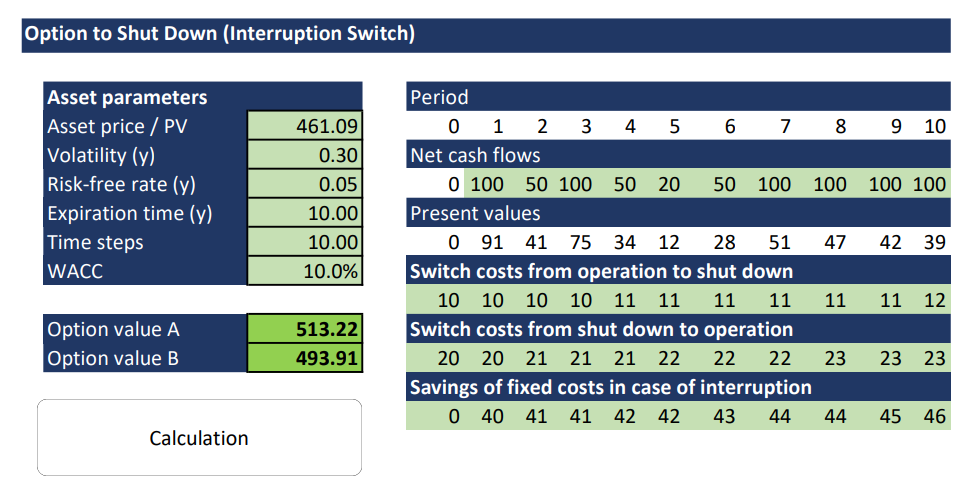
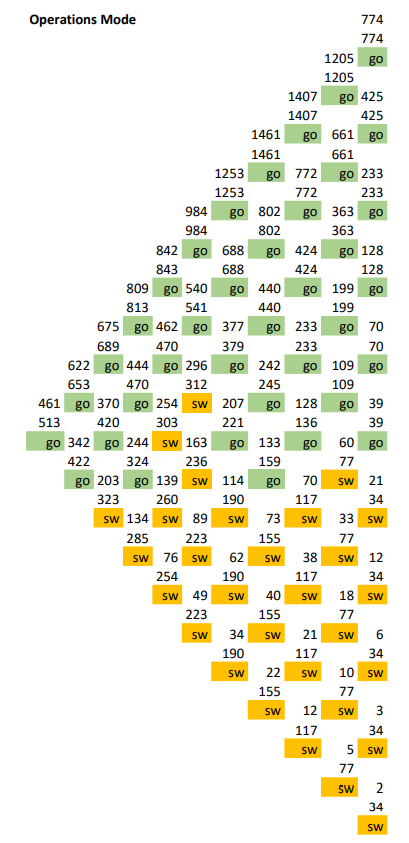
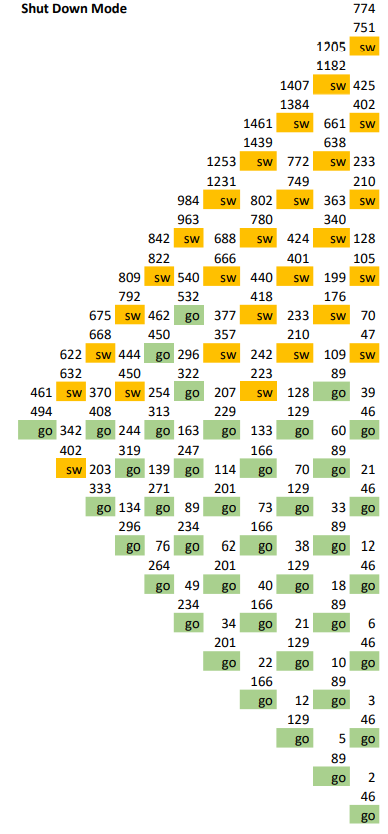
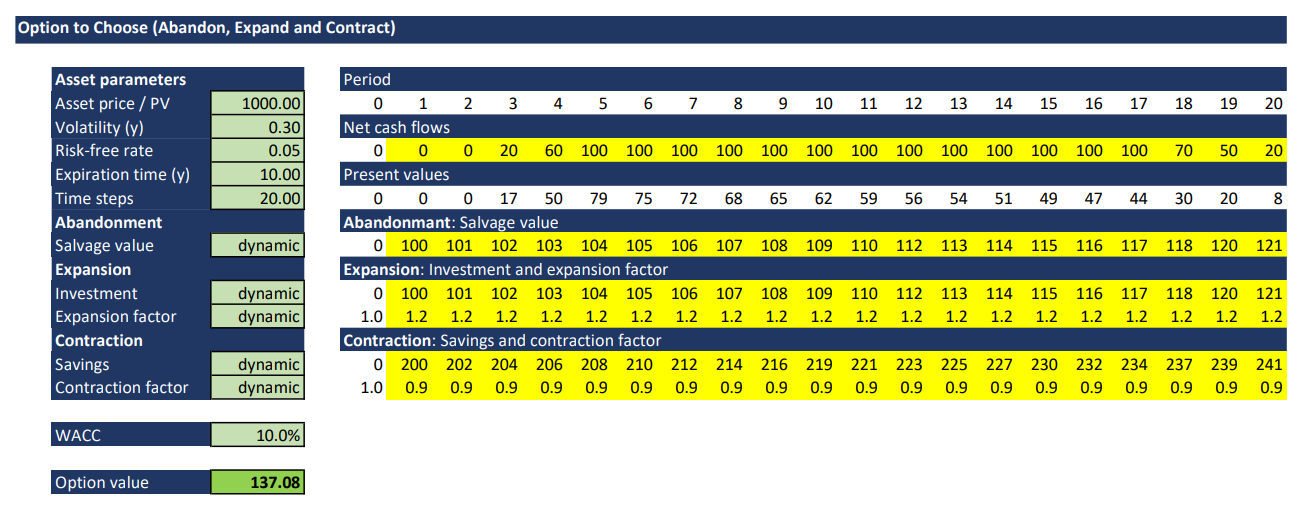
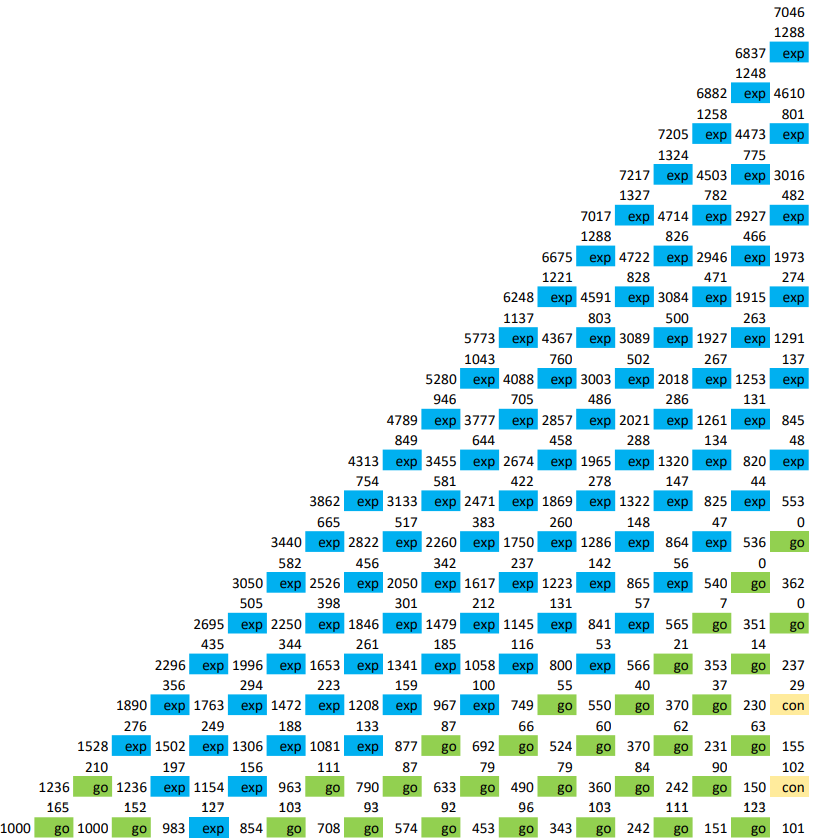
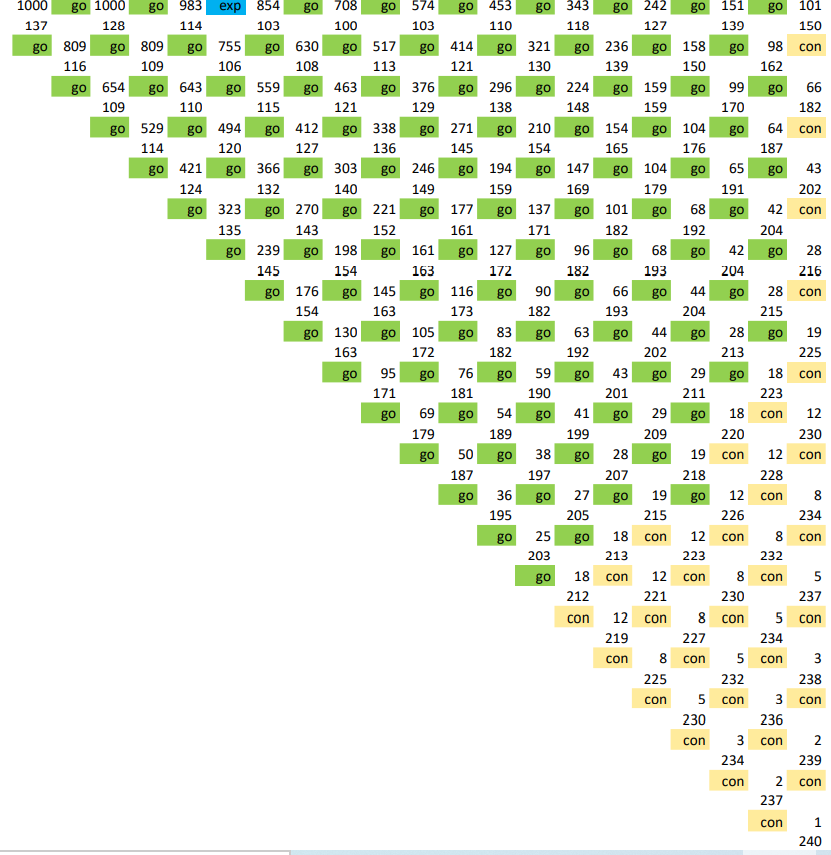
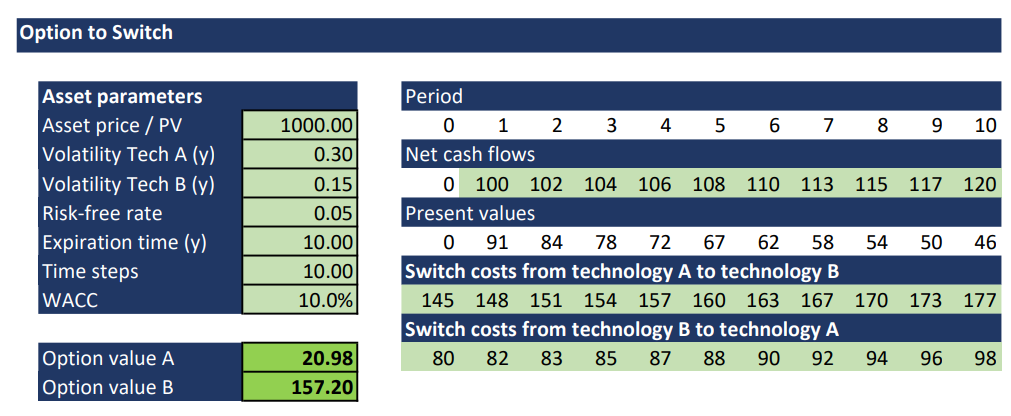
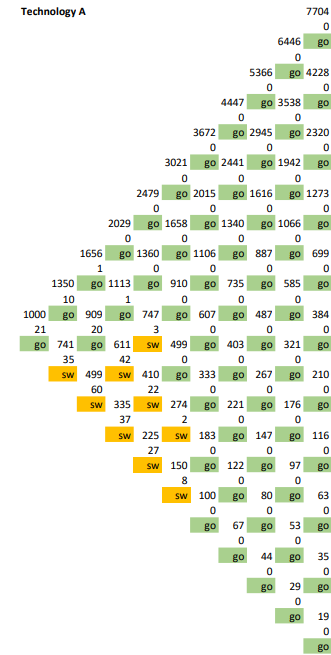
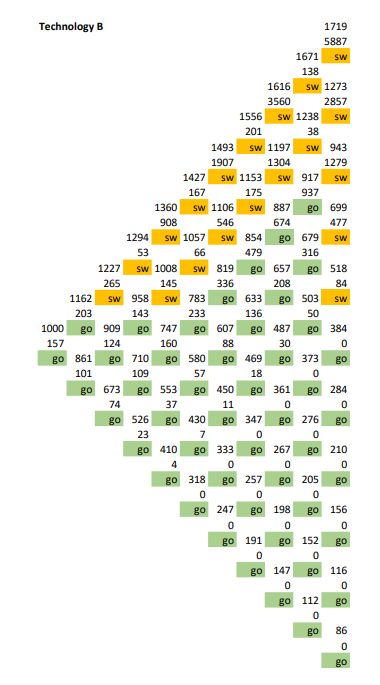
![Rendered by QuickLaTeX.com \[E=\frac{\left(\frac{S\left(1+r\right)-S^-}{S^+-S^-}\right)E^++\left(1-\frac{S\left(1+r\right)-S^-}{S^+-S^-}\right)E^-}{1+r}\]](https://www.financeinvest.at/wp-content/ql-cache/quicklatex.com-bccf07b0c1c2c9b722c78bf7bd5bfd44_l3.png)
